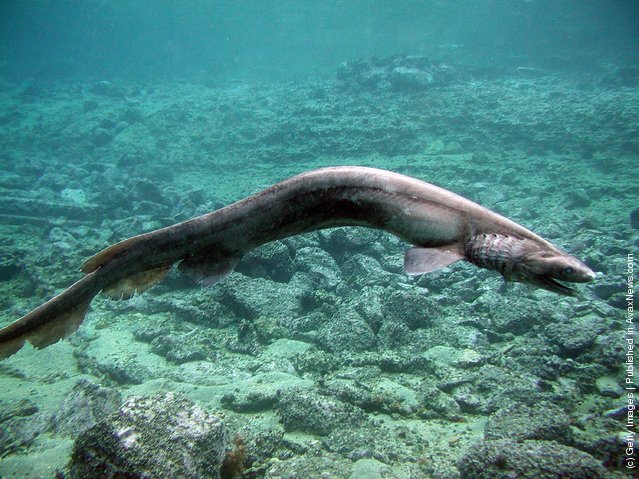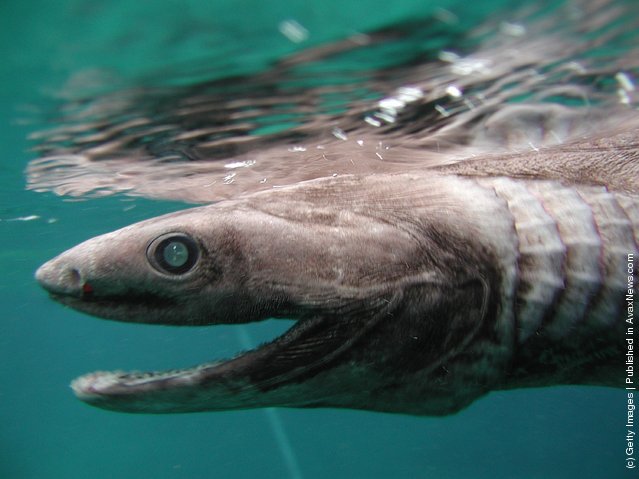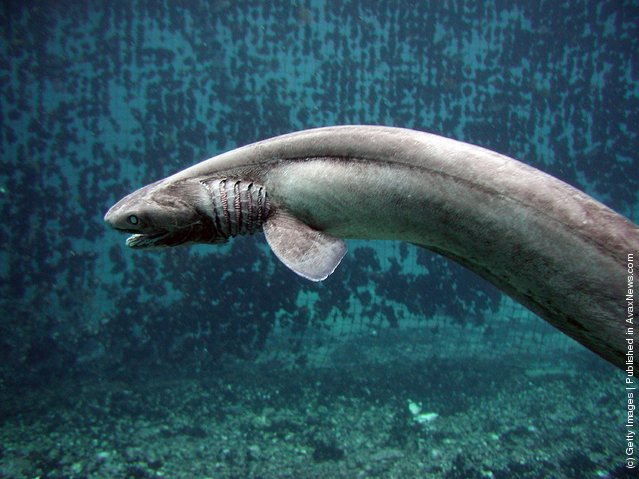“The frilled shark (Chlamydoselachus anguineus) is one of two extant species of shark in the family Chlamydoselachidae, with a wide but patchy distribution in the Atlantic and Pacific Oceans. This uncommon species is found over the outer continental shelf and upper continental slope, generally near the bottom though there is evidence of substantial upward movements. It has been caught as deep as 1,570 m (5,150 ft), whereas in Suruga Bay, Japan it is most common at depths of 50–200 m (160–660 ft). Exhibiting several “primitive” features, the frilled shark has often been termed a «living fossil». It reaches a length of 2 m (6.6 ft) and has a dark brown, eel-like body with the dorsal, pelvic, and anal fins placed far back. Its common name comes from the frilly or fringed appearance of the gill slits, of which there are six pairs with the first pair meeting across the throat.
Seldom observed, the frilled shark is speculated to capture its prey by bending its body and lunging forward like a snake. The long, extremely flexible jaws enable it to swallow large prey whole, while the many rows of small, needle-like teeth prevent escape. It feeds mainly on cephalopods, while also consuming bony fishes and other sharks. This species is aplacental viviparous: the embryos emerge from their egg capsules inside the mother's uterus, and are sustained to term primarily by yolk. The gestation period may be as long as three and a half years, the longest of any vertebrate. Between 2 and 15 young are born at a time; there is no distinct breeding season. Frilled sharks are occasionally captured as bycatch by commercial fisheries but have little economic value. The International Union for Conservation of Nature (IUCN) has assessed it as Near Threatened, since given its very low reproductive rate even incidental catches may deplete its population. This shark, or a supposed giant relative, has been suggested as a source for reports of sea serpents”. – Wikipedia
Photos: A 1.6 meter long Frill shark swims in a tank after being found by a fisherman at a bay in Numazu, on January 21, 2007 in Numazu, Japan. The frill shark, also known as a Frilled shark usually lives in waters of a depth of 600 meters and so it is very rare that this shark is found alive at sea-level. It's body shape and the number of gill are similar to fossils of sharks which lived 350,000,000 years ago. (Photo by Awashima Marine Park/Getty Images)
Seldom observed, the frilled shark is speculated to capture its prey by bending its body and lunging forward like a snake. The long, extremely flexible jaws enable it to swallow large prey whole, while the many rows of small, needle-like teeth prevent escape. It feeds mainly on cephalopods, while also consuming bony fishes and other sharks. This species is aplacental viviparous: the embryos emerge from their egg capsules inside the mother's uterus, and are sustained to term primarily by yolk. The gestation period may be as long as three and a half years, the longest of any vertebrate. Between 2 and 15 young are born at a time; there is no distinct breeding season. Frilled sharks are occasionally captured as bycatch by commercial fisheries but have little economic value. The International Union for Conservation of Nature (IUCN) has assessed it as Near Threatened, since given its very low reproductive rate even incidental catches may deplete its population. This shark, or a supposed giant relative, has been suggested as a source for reports of sea serpents”. – Wikipedia
Photos: A 1.6 meter long Frill shark swims in a tank after being found by a fisherman at a bay in Numazu, on January 21, 2007 in Numazu, Japan. The frill shark, also known as a Frilled shark usually lives in waters of a depth of 600 meters and so it is very rare that this shark is found alive at sea-level. It's body shape and the number of gill are similar to fossils of sharks which lived 350,000,000 years ago. (Photo by Awashima Marine Park/Getty Images)




05 May 2011 10:01:00,
post received
0 comments
